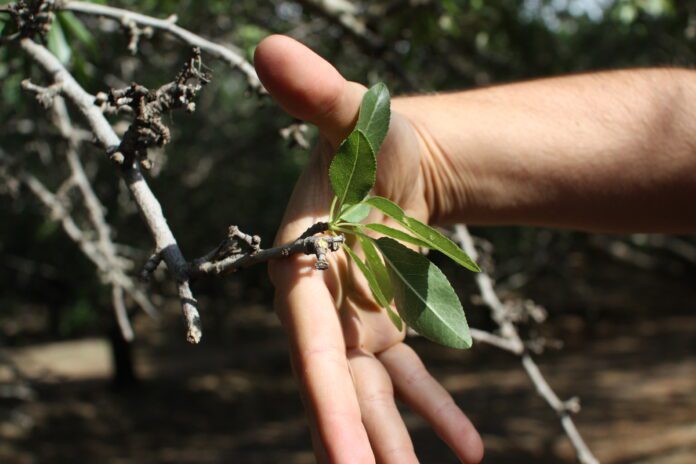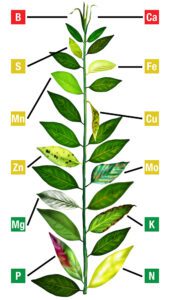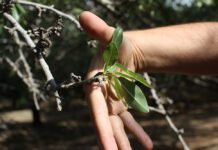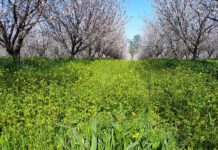
Tree nut growers who want to make sure the right nutrients are available in the right form, the right rate and at the right time have a choice of diagnostic tools. In tree nuts, acquiring the correct information about the nutrient status of your trees is an important part of nutrient management. Critical fertilization decisions are often made based on analysis of the trees’ nutritional status. Growers can also save money by not overapplying fertilizers.
The UC Davis Analytical lab notes sampling plays a critical role in accurate plant health analysis. When analyzing the nutrient status of plants, it is important to select the plant part for chemical analysis that reflects the status of the particular element of interest. Four samplings during a growing season are usually sufficient to characterize seasonal nutritional patterns. The lab recommends one sampling early in the growing season, two in mid-season and the last one just prior to harvest. Four samples should be collected from each field or management unit. Each sample should contain material from at least 20 plants to ensure adequate, representative material for analytical testing. Separate samples should be taken from areas that appear different from the rest of the field.

Past, present and future is one way to look at the differences between two plant health diagnostic tools: leaf sap analysis and tissue analysis. Each provides information on nutrient levels in the plant but sap hones in on available nutrient levels, allowing for proactive correction of imbalances, while tissue quantifies all nutrients in the sample regardless of availability. Cost for either test is relatively inexpensive, but running more sap tests during the year will increase total cost. Sap analysis can have a longer turnaround time as most samples are sent out of state and, in some cases, out of the country.
Sap Analysis
Having only became widely available in the last 10 to 15 years, sap analysis is a diagnostic tool that takes sap extracted from the leaf and analyzes it for its nutritive characteristics. Sap analysis shows the levels and balance of 19 macronutrients and micronutrients from old and young leaves, giving insights into nutrient movement throughout the plant.
“It’s like a blood test for plants,” said Sean Jacobs of Agro-K, a plant nutrition products company. Jacobs said the sap, the liquid portion of the leaf, is extracted from the tissue, so that analysis excludes nearly all structurally bound (and largely unavailable) nutrients. Also included in the analysis is sap sugar content, pH and Ec as well as levels for ammonium, nitrate and total nitrogen. The ability to see only the readily available nutrients offers the opportunity to proactively prepare for and address upcoming nutrient needs.
Over the growing season, the ideal concentrations of nutrients in the sap don’t change, he said, but the rate of use and uptake by the plant does. With sap analysis data, a grower or crop consultant can assess whether their nutritional program is meeting plant demands and correct imbalances before visual deficiency or toxicity symptoms occur.
As a diagnostic tool, sap analysis also helps in understanding the chemical interactions between nutrients as nutritional balance is as important to plant health as nutrient content.
“Often, deficiency or toxicity symptoms are caused by imbalances and interactions among nutrients rather than true deficiencies,” Jacobs said. An example is a crop showing a calcium deficiency. In the case of nutrient imbalances, this positively charged nutrient may be blocked by too much phosphorous, potassium, sodium, magnesium, or ammonium. Sap analysis can identify these imbalances, and rather than adding more calcium, reducing applications of a different nutrient can correct the imbalance and increase the availability and activity of calcium. In these situations, decreasing applications of competing nutrients not only can correct the deficiency, but also saves material and application costs.
Ideally samples should be taken in the early morning when leaves are at their peak hydration, allowing for greater sap extraction volumes with fewer leaves needing to be sampled. Samples for sap analysis can be taken any time the plant has viable leaves.
Leaf Tissue Analysis
Leaf tissue analysis has been a standard plant nutrient testing method for many years and provides timely information that enables adjustment of fertilization programs so nutritional problems can be prevented.
This method determines if a tree has sufficient supply of essential nutrients for growth and production. It also can confirm nutritional deficiencies and helps with evaluation of a fertilizer program. Analysis of the leaf tissue shows if key macronutrients like nitrogen, phosphorous and potassium are at optimal levels for growth and yield.
Leaf samples are best taken during the growing season to show the status of the plants at the time of sampling. Sebastian Saa, senior manager of agricultural research at Almond Board of California, said research has led to an updated tissue sampling protocol earlier in the growing season, 43 days after full bloom, to give growers time to adjust their nitrogen applications if necessary. The sampling can also present a picture of how trees reacted to nitrogen applications the prior season.
Sampling procedure notes leaves should be representative of the orchard. Leaves in the sample should be collected from around the canopy from at least eight well exposed non-fruiting spurs located 5 to 7 feet from the ground. There should be a minimum of 100 leaves per bag. Saa noted the lab should be asked to apply the UCE-ESP guidelines for interpreting April tissue values.
Jeff Carr, director of grower relations at Deerpoint Group, said plant tissue analysis detects unseen deficiencies and can confirm visual symptoms of deficiencies. Toxic levels of key nutrients, if present, are detected. Over time, trends in nutrient status of permanent crops including almond trees can be tracked with leaf tissue analysis.
Carr said the laboratory test results of leaf tissue samples can be delivered within 24 hours, allowing for faster correction in nutrient delivery.
Diagnostic Tools
Regardless of which diagnostic tool is used by a grower to determine essential nutrient concentrations in plant samples, it can provide a plan to remedy nutritional shortcomings or verify that a fertilization plan is working. Tests can eliminate guesswork when adjusting a fertilization program. The goal when using either of these methods is to prevent deficiencies and overapplication.

Cecilia Parsons | Associate Editor
Cecilia Parsons has lived in the Central Valley community of Ducor since 1976, covering agriculture for numerous agricultural publications over the years. She has found and nurtured many wonderful and helpful contacts in the ag community, including the UCCE advisors, allowing for news coverage that focuses on the basics of food production.
She is always on the search for new ag topics that can help growers and processors in the San Joaquin Valley improve their bottom line.
In her free time, Cecilia rides her horse, Holly in ranch versatility shows and raises registered Shetland sheep which she exhibits at county and state fairs during the summer.















